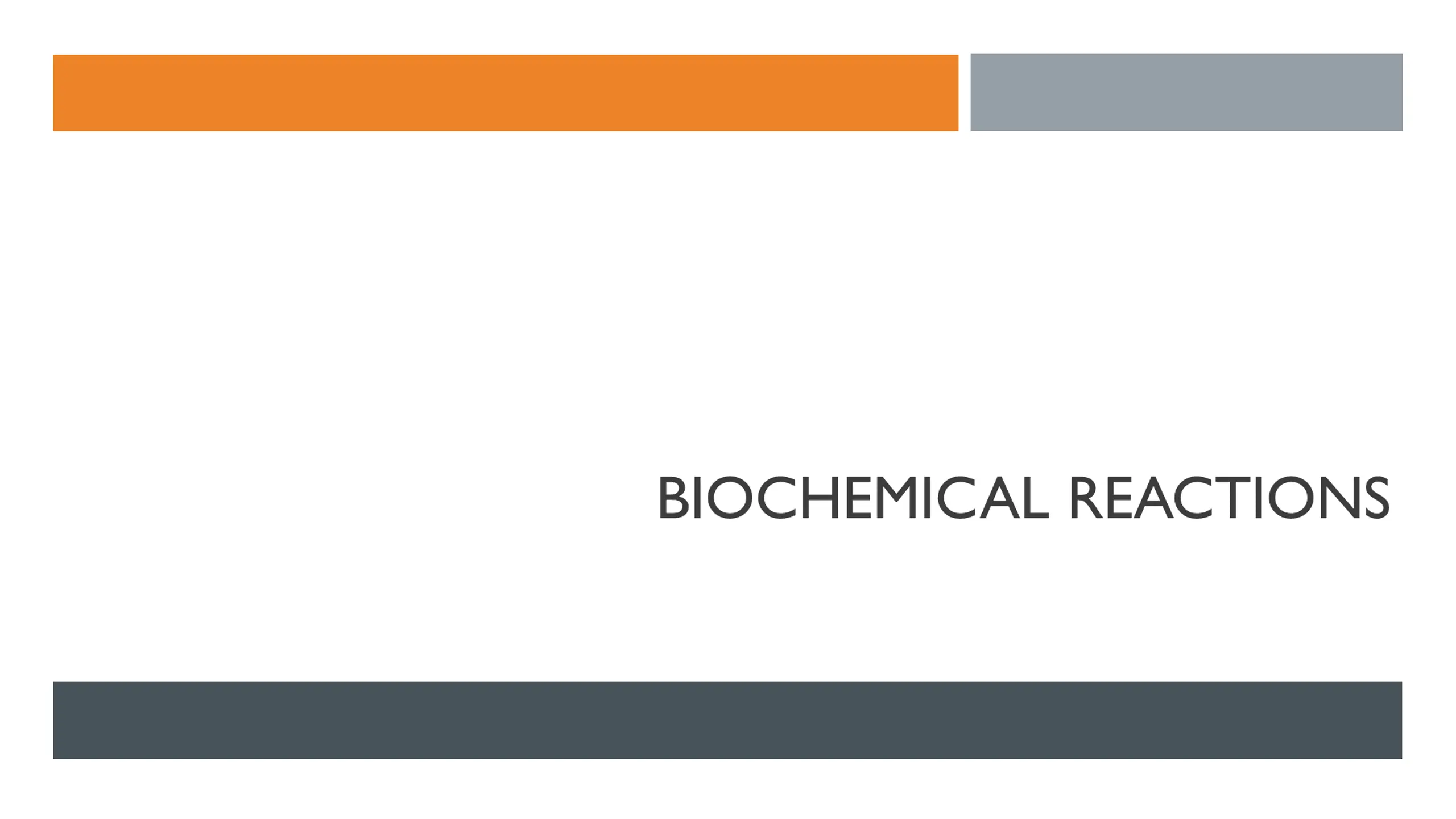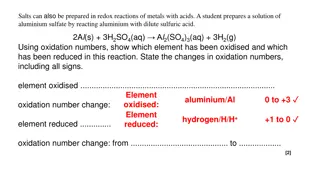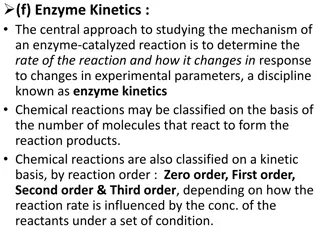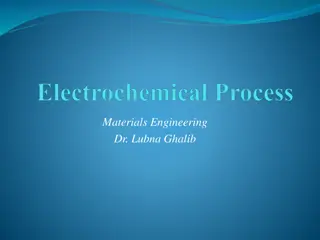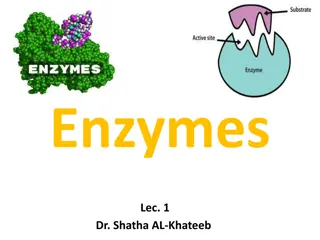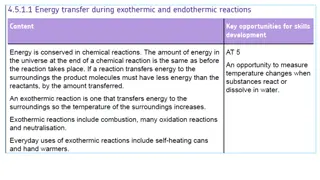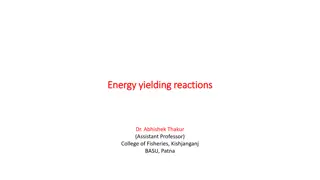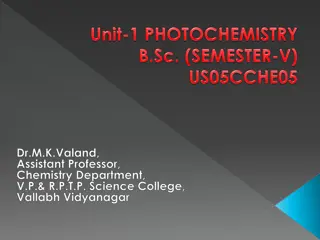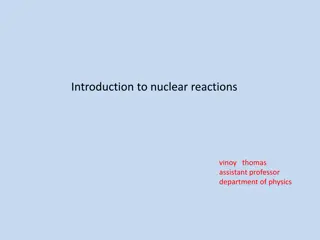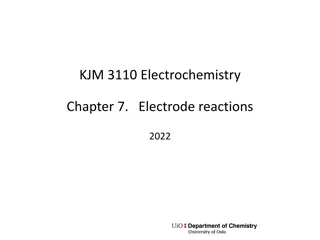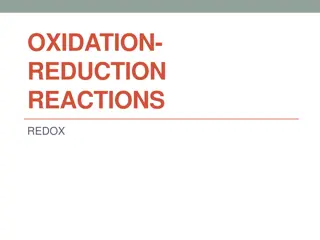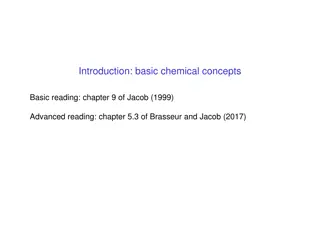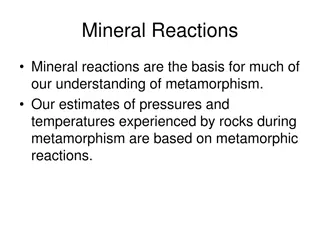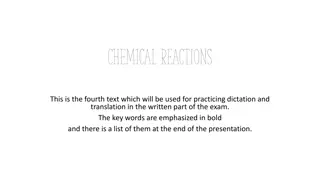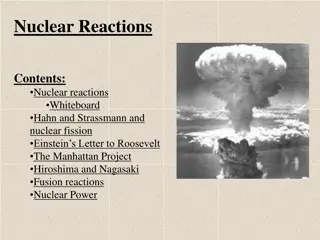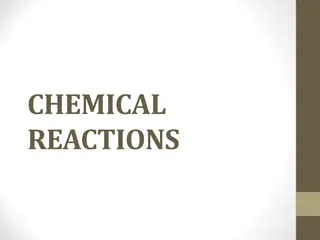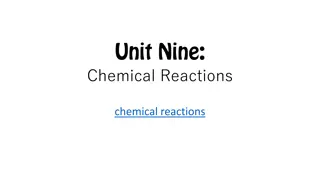Biochemical Reactions
Exploring the basics of chemical reactions, the conservation of matter principle, exothermic and endothermic reactions, and the role of activation energy in jumpstarting reactions. Learn how elements transform to create products, the significance of energy release or absorption, and the essential concept of activation energy in initiating reactions.
Download Presentation

Please find below an Image/Link to download the presentation.
The content on the website is provided AS IS for your information and personal use only. It may not be sold, licensed, or shared on other websites without obtaining consent from the author.If you encounter any issues during the download, it is possible that the publisher has removed the file from their server.
You are allowed to download the files provided on this website for personal or commercial use, subject to the condition that they are used lawfully. All files are the property of their respective owners.
The content on the website is provided AS IS for your information and personal use only. It may not be sold, licensed, or shared on other websites without obtaining consent from the author.
E N D
Presentation Transcript
Introduction The element chlorine (Cl) is a greenish poison. Would you eat chlorine? Of course not, but you often eat a compound containing chlorine. In fact, you probably eat this chlorine compound just about every day. Do you know what it is? It s table salt. Table salt is sodium chloride (NaCl), which forms when chlorine and sodium (Na) combine in certain proportions. How does chlorine, a toxic green chemical, change into harmless white table salt? It happens in a chemical reaction. What Are Chemical Reactions? A chemical reaction is a process that changes some chemical substances into others. A substance that starts a chemical reaction is called a reactant, and a substance that forms as a result of a chemical reaction is called a product. During a chemical reaction, the reactants are used up to create the products. An example of a chemical reaction is the burning of methane. In this chemical reaction, the reactants are methane (CH4) and oxygen (O2), and the products are carbon dioxide (CO2) and water (H2O). A chemical reaction involves the breaking and forming of chemical bonds. When methane burns, bonds break in the methane and oxygen molecules, and new bonds form in the molecules of carbon dioxide and water. A chemical reaction can be represented by a chemical equation. For example, the burning of methane can be represented by the chemical equation: CH4+ 2O2 CO2+ 2H2O
Conservation of Matter In a chemical reaction, the quantity of each element does not change; there is the same amount of each element in the products as there was in the reactants. This is because matter is always conserved. The conservation of matter is reflected in a reaction s chemical equation. The same number of atoms of each element appears on each side of the arrow. For example, in the chemical equation above, there are four hydrogen atoms on each side of the arrow. Can you find all four of them on each side of this equation? Chemical Reactions and Energy Chemical reactions always involve energy. When methane burns, for example, it releases energy in the form of heat and light. Other chemical reactions absorb energy rather than release it. Exothermic Reactions A chemical reaction that releases energy (as heat) is called an exothermic reaction. This type of reaction can be represented by a general chemical equation: Reactants Products + Heat In addition to methane burning, another example of an exothermic reaction is chlorine combining with sodium to form table salt. This reaction also releases energy.
Endothermic Reactions A chemical reaction that absorbs energy is called an endothermic reaction. This type of reaction can also be represented by a general chemical equation: Reactants + Heat Products Did you ever use a chemical cold pack called dry ice? The pack cools down because of an endothermic reaction. When a tube inside the pack is broken, it releases a chemical that reacts with water inside the pack. This reaction absorbs heat energy and quickly cools down the pack. Activation Energy All chemical reactions need energy to get started. Even reactions that release energy need a boost of energy in order to begin. The energy needed to start a chemical reaction is called activation energy. Activation energy is like the push a child needs to start going down a playground slide. The push gives the child enough energy to start moving, but once she starts, she keeps moving without being pushed again. Why do all chemical reactions need energy to get started? In order for reactions to begin, reactant molecules must bump into each other, so they must be moving, and movement requires energy. When reactant molecules bump together, they may repel each other because of intermolecular forces pushing them apart. Overcoming these forces so the molecules can come together and react also takes energy.
Biochemical Reactions and Enzymes Biochemical reactions are chemical reactions that take place inside the cells of living things. The field of biochemistry demonstrates that knowledge of chemistry as well as biology is needed to understand fully the life processes of organisms at the level of the cell. The sum of all the biochemical reactions in an organism is called metabolism. It includes both exothermic and endothermic reactions. Types of Biochemical Reactions Exothermic reactions in organisms are called catabolic reactions. These reactions break down molecules into smaller units and release energy. An example of a catabolic reaction is the breakdown of glucose, which releases energy that cells need to carry out life processes. Endothermic reactions in organisms are called anabolic reactions. These reactions build up bigger molecules from smaller ones. An example of an anabolic reaction is the joining of amino acids to form a protein. Enzymes Most biochemical reactions in organisms need help in order to take place. Why is this the case? For one thing, temperatures are usually too low inside living things for biochemical reactions to occur quickly enough to maintain life. The concentrations of reactants may also be too low for them to come together and react. Where do the biochemical reactions get the help they need to proceed? The help comes from enzymes.
An enzyme is a protein that speeds up a biochemical reaction. An enzyme works by reducing the amount of activation energy needed to start the reaction. Less activation energy is needed when the correct enzyme is present than when it is not present. Enzymes are involved in most biochemical reactions, and they do their job extremely well. A typical biochemical reaction could take several days to occur without an enzyme. With the proper enzyme, the same reaction can occur in just a split second! Without enzymes to speed up biochemical reactions, most organisms could not survive. The activities of enzymes depend on the temperature, ionic conditions, and the pH of the surroundings. Some enzymes work best at acidic pHs, while others work best in neutral environments. Lesson Summary A chemical reaction is a process that changes some chemical substances into others. It involves breaking and forming chemical bonds. Some chemical reactions release energy, whereas other chemical reactions absorb energy. All chemical reactions require activation energy to get started. Enzymes are needed to speed upbiochemical reactionsin organisms. They work by lowering activation energy. Vocabulary activation energy anabolic reaction biochemical reaction catabolic reaction endothermic reaction enzyme exothermic reaction metabolism product reactant
Multiple Choice 1. CH4 + 2O2 CO2 + 2H2O. The products in this reaction include: a. methane and oxygen. b. carbon dioxide and water. c. carbon dioxide and oxygen. d. methane and water. 2. The push needed to start a chemical reaction is the: a. enzymatic energy. b. endothermic energy. c. activation energy. d. reactant energy. 3. Enzymes are: a. carbohydrates that store biological energy. b. lipids that form biological membranes. c. proteins that speed up biochemical reactions. d. nucleic acids that have the information to make proteins. 4. Organisms need enzymes because: a. temperatures may too low inside organisms for reactions to occur without enzymes. b. the levels of reactants may be too low for them to react without assistance from enzymes. c. they need biochemical reactions to speed up to occur quickly enough to maintain life. d. all of the above
5. An example of a catabolic reaction is: a. making starch from monosaccharides. b. the formation of proteins from amino acids. c. the breakdown of glucose to release energy. d. the joining of nucleotides in the copying of DNA. 6. Without enzymes, you could not: a. burn methane into carbon dioxide and water. b. photosynthesize and make glucose from carbon dioxide and water. c. break down glucose into carbon dioxide and water. d. You could do all of the above without enzymes. 7. Activation energy is required in which of the following reactions? a. biochemical reactions only b. only endothermic reactions c. only exothermic reactions d. all chemical reactions 8. The action of enzymes is crucial to life. Enzymes act by: a. lowering the activation energy needed to start the reaction. b. reducing the amount of energy absorbed during a biochemical reaction. c. reducing the amount of heat released during a biochemical reaction. d. conserving matter in a biochemical reaction, such that the number of atoms in the reactants equals the number in the products.
9. Which represents the correct depiction of an exothermic reaction? a. Reactants + Heat Products b. Reactants Products + Heat c. Reactants + Products Heat d. Products + Heat Reactants 10. The activities of enzymes depend on: a. temperature. b. ionic conditions. c. pH of the surroundings. d. all of the above. 11. What is the main difference between an endothermic reaction and an exothermic reaction? a. An endothermic reaction gives off energy and an exothermic reaction absorbs energy. b. An exothermic reaction gives off energy and an endothermic reaction absorbs energy. c. An endothermic reaction does not need activation energy. d. Only an endothermic reaction involves enzymes.
True or False _______ 1. An enzyme speeds upbiochemical reactionsby lowering the activation energy. _______ 2. The number of atoms in the reactants of a chemical reaction is always the same as the number of atoms in the products. _______ 3. Not all chemical reactions involve energy. _______ 4. The joining of amino acids to form a protein is a catabolic reaction, building up bigger molecules from smaller ones. _______ 5. Enzymes are necessary for life. Fill in the Blanks 1. _______________ reactions are chemical reactions that take place inside cells. 2. _______________ reactions in organisms are called catabolic reactions. 3. _______________ energy is the energy needed to start a chemical reaction. 4. The sum of all the ________________ in an organism is called metabolism. 5. In a reaction involving sodium and chlorine, table salt (sodium chloride) is the ________________. 6. During a chemical reaction, _______________ is always conserved. 7. A(n) ________________ is a protein that speeds up a biochemical reaction. 8. A substance that is used to start a chemical reaction is called a ________________.
Introduction Water, like carbon, has a special role in living things. It is needed by all known forms of life. As you have seen, water is a simple molecule, containing just three atoms. Nonetheless, water s structure gives it unique properties that help explain why it is vital to all living organisms. Water Everywhere Water is a common chemical substance on planet Earth. In fact, Earth is sometimes called the water planet because almost 75% of its surface is covered with water. The term water generally refers to its liquid state, and water is a liquid over a wide range of temperatures on Earth. However, water also occurs on Earth as a solid (ice) and as a gas (water vapor). Structure and Properties of Water No doubt, you are already aware of some of the properties of water. For example, you probably know that water is tasteless and odorless. You also probably know that water is transparent, which means that light can pass through it. This is important for organisms that live in the water because some of them need sunlight to make food. Chemical Structure of Water To understand some of water s properties, you need to know more about its chemical structure. As you have seen, each molecule of water consists of one atom of oxygen and two atoms of hydrogen. The oxygen atom in a water molecule attracts electrons more strongly than the hydrogen atoms do. As a result, the oxygen atom has a slightly negative charge, and the hydrogen atoms have a slightly positive charge. A difference in electrical charge between different parts of the same molecule is called polarity.
Opposites attract when it comes to charged molecules. In the case of water, the positive (hydrogen) end of one water molecule is attracted to the negative (oxygen) end of a nearby water molecule. Because of this attraction, weak bonds form between adjacent water molecules. The type of bond that forms between molecules is called a hydrogen bond. Bonds between molecules are not as strong as bonds within molecules, but in water they are strong enough to hold together nearby molecules. Properties of Water Hydrogen bonds between water molecules explain some of water s properties. For example, hydrogen bonds explain why water molecules tend to stick together. Did you ever watch water drip from a leaky faucet or from a melting icicle? If you did, then you know that water always falls in drops rather than as separate molecules. Hydrogen bonds cause water to have a relatively high boiling point of 100 C (212 F). Because of its high boiling point, most water on Earth is in a liquid state rather than in a gaseous state. Water in its liquid state is needed by all living things. Hydrogen bonds also cause water to expand when it freezes. This, in turn, causes ice to have a lower density (mass/volume) than liquid water. The lower density of ice means that it floats on water. For example, in cold climates, ice floats on top of the water in lakes. This allows lake animals such as fish to survive the winter by staying in the water under the ice.
Acids and Bases Water is the main ingredient of many solutions. A solution is a mixture of two or more substances that has the same composition throughout. Some solutions are acids, and some are bases. To understand acids and bases, you need to know more about pure water. In pure water (such as distilled water), a tiny fraction of water molecules naturally breaks down to form ions. An ion is an electrically charged atom or molecule. The breakdown of water is represented by the chemical equation: 2 H2O H3O++ OH- The products of this reaction are a hydronium ion (H3O+) and a hydroxide ion (OH-). The hydroxide ion, which has a negative charge, forms when a water molecule gives up a positively charged hydrogen ion (H+). The hydronium ion, which has positive charge, forms when another water molecule accepts the hydrogen ion. Acidity and pH The concentration of hydronium ions in a solution is known as acidity. In pure water, the concentration of hydronium ions is very low; only about 1 in 10 million water molecules naturally breaks down to form a hydronium ion. As a result, pure water is essentially neutral. Acidity is measured on a scale called pH. Pure water has a pH of 7, so the point of neutrality on the pH scale is 7.
Acids If a solution has a higher concentration of hydronium ions than pure water, it has a pH lower than 7. A solution with a pH lower than 7 is called an acid. As the hydronium ion concentration increases, the pH value decreases. Therefore, the more acidic a solution is, the lower its pH value is. Did you ever taste vinegar? Like other acids, it tastes sour. Stronger acids can be harmful to organisms. For example, stomach acid would eat through the stomach if it were not lined with a layer of mucus. Strong acids can also damage materials, even hard materials suchas glass. Bases If a solution has a lower concentration of hydronium ions than pure water, it has a pH higher than 7. A solution with a pH higher than 7 is called a base. Bases, such as baking soda, have a bitter taste. Like strong acids, strong bases can harm organisms and damage materials. For example, lye can burnthe skin, and bleach can remove the color from clothing. Acids and Bases in Organisms Acids and bases are important in living things because most enzymes can do their job only at a certain level of acidity. Cells secrete acids and bases to maintain the proper pH for enzymes to work. For example, every time you digest food, acids and bases are at work in your digestive system. Consider the enzyme pepsin, which helps break down proteins in the stomach. Pepsin needs an acidic environment to do its job, and the stomach secretes a strong acid that allows pepsin to work. However, when stomach contents enter the small intestine, the acid must be neutralized. This is because enzymes in the small intestine need a basic environment in order to work. An organ called the pancreas secretes a strong base into the small intestine, and this base neutralizes the acid.
Water and Life The human body is about 70% water (not counting the water in body fat, which varies from person to person). The body needs all this water to function normally. Just why is so much water required by human beings and other organisms? Water can dissolve many substances that organisms need, and it is necessary for many biochemical reactions. As a result, just about all life processes depend on water. Clearly, life as we know it could not exist without water. Lesson Summary Most of Earth s water is salt water in the oceans. Less than 3% is freshwater. Water molecules are polar, so they form hydrogen bonds. This gives water unique properties, such as a relatively high boiling point. The extremely low hydronium ion concentration of pure water gives pure water a neutral pH of 7. Acids have a pH lower than 7, and bases have a pH higher than 7. Water is involved in most biochemical reactions. Therefore, water is essential to life.
Multiple Choice 1. The oxygen in a water molecule: a. attracts electrons more strongly than the hydrogen atoms. b. has a slight negative charge. c. binds to a hydrogen of another water molecule through a hydrogen bond. d. all of the above 2. Most of the water on Earth can be found as: a. freshwater in icecaps, glaciers and the inland seas. b. freshwater in lakes, the atmosphere and as moisture in soil. c. saltwater in lakes, the atmosphere and as moisture in soil. d. saltwater in the oceans. 3. Acids have a pH: a. less than 14. b. between 0 and 14. c. between 0 and 7. d. between 7 and 14.
4. Ice floats on water because: a. ice has a lower density than water. b. water contracts when it freezes. c. of the boiling point of water. d. all of the above 5. How do hydrogen bonds affect water s properties? a. Hydrogen bonds explain why water molecules stick together. b. Hydrogen bonds cause water to have a relatively high boiling point. c. Hydrogen bonds also cause water to expand when it freezes. d. all of the above True or False _______ 1. Water is a chemical. _______ 2. Water is a product of photosynthesis. _______ 3. Water is a polar molecule it has regions with different charges. _______ 4. Pure water has a pH of 7. _______ 5. The inside of your stomach has a low pH. _______ 6. Most of the water on Earth consists of freshwater in the oceans. _______ 7. The hydrogen bonds that hold water molecules together are very strong bonds. _______ 8. Ammonia is a very strong acid. _______ 9. The oxygen atom in a water molecule attracts electrons more strongly than the hydrogen atoms.
Fill in the Blanks 1. Water s _______________ gives it unique properties that are important to understand its importance. 2. The positive end of one water molecule is attracted to the _______________ end of a nearby water molecule. 3. A _______________ is a mixture of two or more substances with the same composition throughout. 4. The _______________ point of water is 100 C. 5. The pH scale ranges from _______________ to _______________. 6. A difference in electrical charge between different parts of the same molecule is called _______________. 7. Your stomach is a very _______________ environment. 8. _______________ bonds form between adjacent water molecules.
